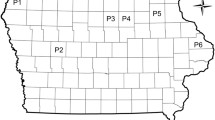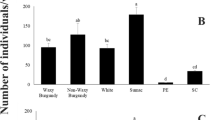Abstract
Use of microorganisms to manage insect pests is a strategy compatible with organic production, but variability in their effectiveness limits the adoption by growers. Prior reports indicated that increased resistance to a fungal plant pathogen in dent maize inbreds was associated with reduced efficacy of the commercialized fungal biocontrol agent Beauveria bassiana in killing maize caterpillar pests, but this aspect has not been investigated with sweet corn. Several varieties of sweet corn certified for organic production, along with sweet corn inbreds that have been used in breeding commercial sweet corn hybrids, were evaluated for their influence on the efficacy of two commercial strains of Beauveria bassiana. As occurred in prior dent corn studies, significant differences were noted in mortality levels on day 2 for European corn borers (ranging from as much as 14.9 to 58.6%) and fall armyworms (ranging from as much as 12.1 to 46.0%) depending on the sweet corn hybrids and inbreds. Higher rates of leaf colonization by B. bassiana were associated with larger lesion sizes caused by the maize pathogen Fusarium graminearum for both hybrids and inbreds. However, greater efficacy of B. bassiana in killing insects was associated with smaller lesion sizes caused by F. graminearum for some organic production sweet corn hybrids. This information indicates it is possible to develop sweet corn varieties that are both resistant to fungal pathogens and compatible with use of B. bassiana and suggests this aspect can be further improved to promote more effective organic production of sweet corn.



Similar content being viewed by others
Data availability
All data generated in this study are included in the text and tables of this published article.
Code availability
Not relevant.
References
AgDaily (2019) The list of organic pesticides approved by the USDA. https://www.agdaily.com/category/technology. Accessed 8–29–23
Amobonye A, Bhagwat P, Pandey A, Singh S, Pillai S (2020) Biotechnological potential of Beauveria bassiana as a source of novel biocatalysts and metabolites. Crit Rev Biotechnol 40:1019–1034
Anatis Bioprotection Inc (2023) BioCeres® WP. www.anatisbioprotection.com/en/product.bioceres-wp. Accessed 8–17–23
Athey KJ (2021) Control of sweet corn insect pests. University of Illinois Extension. https://extension.illinois.edu/sites/default/files/control_of_sweet_corn_insect_pests.pdf. Accessed 8-17-23
Baker BP, Green TA, Loker AJ (2020) Biological control and integrated pest management in organic and conventional systems. Biol Control 140:104095
Balint-Kurti P, Simmons SJ, Blum JE, Ballaré CL, Stapleton AD (2010) Maize leaf epiphytic bacteria diversity patterns are genetically correlated with resistance to fungal pathogen infection. MPMI 23:473–484
Bark Y, Lee D, Kim Y, Kang S (1996) Antibiotic properties of an entomopathogenic fungus, Beauveria bassiana, on Fusarium oxysporum and Botrytis cinera. Korean J Plant Pathol 12:245–250
Beres PK (1996) Efficacy of spinosad and Bacillis thuringiensis var. kurstaki in biological control of the European corn borer on sweet corn. Acta Sci Pol Hortorum Cultus 15:19–35
Certis Bio (2023) BotaniGuard®. www.certisbio.com/greenhouse/products/botaniguard. Accessed 8–17–23
Correa OS, Romero AM, Montecchia MS, Soria MA (2007) Tomato genotype and Azospirillum inoculation modulated the changes in bacterial communities associaed with roots and leaves. J Appl Microbiol 102:781–786
Culebro-Ricaldi J, Ruíz-Valdiviezo V, Rodríguez-Mendiola MA, Avila Miranda ME, Gutiérrez-Miceli F, Cruz-Rodríguez RI, Dendooven L, Montes-Molina J (2017) Antifungal properties of Beauveria bassiana strains against Fusarium oxysporum f. sp. lycopersici race 3 in tomato crop. J Environ Biol 38:821–827
Dara SK (2019) Non-entomopathogenic role of entomopathogenic fungi in promoting plant health and growth. Insects 10:277. https://doi.org/10.3390/insects10090277
Dowd PF (1988) Toxicological and biochemical interactions of the fungal metabolites fusaric acid and kojic acid with xenobiotics in Heliothis zea (F.) and Spodoptera frugiperda (J. E. Smith). Pestic Biochem Physiol 32:123–134
Dowd PF (2021) Enhanced rates of lethality to fall armyworms (Spodoptera frugiperda) after association of Beauveria bassiana strain Ant 03 with sweet corn leaves. Biocontrol Sci Technol 31:877–882
Dowd PF, Johnson ET (2022) Different maize (Zea mays L.) inbreds influence the efficacy of Beauveria bassiana against major maize caterpillar pests, which is potentially affected by maize pathogen resistance. Biocontrol Sci Technol 32:847–862
Dowd PF, Johnson ET, Pinkerton TS (2007) Oral toxicity of β-N acetyl hexosaminidase to insects. J Agric Food Chem 55:3421–3428
Dowd PF, Johnson ET, Price NP (2012) Enhanced pest resistance of maize leaves expressing monocot crop plant derived ribosome inactivating protein and agglutinin. J Agri Food Chem 60:10768–10775
Dowd PF, Naumann TA, Johnson ET, Price NP (2019) A maize hydrolase with activity against maize insect and fungal pests. Plant Gene 21. https://doi.org/10.1016/j.plgene.2019.10021
Feng M, Zhang Y, Coates BS, Du Q, Gao Y, Li L, Yuan H, Sun W, Chang X, Shou S, Wang Y (2023) Assessment of Beauveria bassiana for the biological control of corn borer Ostrinia furnacalis, in sweet maize by irrigation application. Biocontrol 68:49–60
Gailpa DS, Miedaner T (2019) Genomics-assisted breeding for ear rot resistances and reduced mycotoxin contamination in maize: methods, advances and prospects. Theor Appl Gen 132:2721–2739
Gerdes JT, Behr CF, Coors JG, Tracy WF (1993) Sweet corn inbred lines. Compilation of North American maize breeding germplasm. Crop Science Society of America, Madison, WI, pp 153–193
Germplasm Resource Information Network (2023). Accessed 8–3–2023
Hare JD, Andreadis TG (1983) Variation in the susceptibility of Leptinotarsa decemlineata (Coleoptera: Chrysomelidae) when reared on different host plants to the fungal pathogen Beauveria bassiana in the field and laboratory. Environ Entomol 12:1892–1897
JAAB of the Carolinas (2023) SPE-120 soil and plant enhancer. www.jaabofthecarollinas.com/wp-content/uploads/2022/11/JAAB_sales-sheet_2023-SPE120_3-LR-WEB-1.pdf. Accessed 8–17–23
Johnny’s Select Seed (2023) Sweet corn. www.johnnyseeds.com/vegetables/corn/sweet-corn. Accessed 8–17–23
Luo K, Zhao G, Chen M, Tian X (2023) Effects of maize resistance and leaf chemical substances on the structure of phyllosphere fungal communities. Front Plant Sci 14:1241055. https://doi.org/10.3389/fpls.2023.1241055
Mascarin GM, Jaronski ST (2016) The production and uses of Beauveria bassiana as a microbial insecticide. World J Microbiol Biotechnol 32:177–203
McGrath MT (2021) Sweet corn disease and control measures. Cornell College of Agriculture and Life Sciences. https://www.vegetables.cornell.edu.pest-management/disease-factshets/sweet-corn-diseases-and-control-measures. Accessed 8–17–23
Peterson D (2020) Pest control strategies for organic sweet corn. https://organicgrower.info/article/pest-control-strategies-for-organic-sweet-corn Accessed 8–17–23
Ramoska WA, Todd T (1985) Variation in efficacy and viability of Beauveria bassiana in the chinch bug (Hemiptera: Lygaeidae) as a result of feeding activity on selected host plants. Environ Entomol 14:146–148
Revilla P, Anibase CM, Tracy WF (2021) Sweet corn research around the world 2015–2020. Agronomy 11:534. https://doi.org/10.3390/agronomy11030534
Rushton P (2023) Beauveria bassiana can reduce fertilizer costs. https://lpcnaturals.com/beauveria-bassiana-can-reduce-fertilizer-costs. Accessed 8-17-23
Russo ML, Scorsetti AC, Vianna MF, Cabello M, Ferreri N, Pelizza S (2019) Endophytic effects of Beauveria bassiana on corn (Zea mays) and its herbivore, Rachiplusia nu (Lepidoptera: Noctuidae). Insects 10:110. https://doi.org/10.3390/insects100440110
Sapkota R, Knorr K, Jørgensen LN, O’Hanlon KA, Nicolaisen M (2015) Host genotype is an important determinant of the cereal phyllosphere microbiome. New Phytol 207:1134–1144
Harris Seed (2023) Organic sweet corn. www.harrisseeds.com/collections/organic-sweet-corn. Accessed 8–17–23
Siddiq M, Pascali MM (2018) Peas, sweet corn, and green beans. Handbook of vegetables and vegetable processing. pp.761-783. https://doi.org/10.1002/9781119098935.ch33
Silva BA, Rosa R, Silva JR, Savi Gd, Scussel VM (2017) Natural occurrence of fumonisins and characteristics of pamonhas sweet type from Southern Brazil. Food Adddit Contam Part B 10:222–227
Singleton WR, Jones DF (1936) Sweet corn inbreds. Conn Agric Exper Stat Circular 112:51–58
Singleton WR (1948) Hybrid sweet corn. Conn Agric. Exper Stat Bull 518, 60 pp
Sivparsad BJ, Laing MD (2016) Pre-harvest silk treatment with Trichoderma harzianum reduces aflatoxin contamination in sweet corn. J Plant Dis Prog 123:285–293
Sparks TC, Dripps JE, Watson GB, Paroonagian D (2012) Resistance and cross-resistance to the spinosyns – a review and analysis. Pestic Biochem Physiol 102:1–10
Tabashnik BE, Fabrik JA, Carriere Y (2023) Global patterns of insect resistance to transgenic Bt crops: the first 25 years. J Econ Entomol 116:297–309
Taheri P (2018) Cereal disease caused by Fusarium graminearum: from biology of the pathogen to oxidative burst related host responses. Eur J Plant Pathol 152:1–20
TechSci (2017) Global organic food market by product type (organic meat, poultry and dairy; organic fruits and vegetables; organic processed food; etc.), by region (Europe, North America, Asia-Pacific, etc.), competition forecast and opportunities, 2012 -2022. https://www.techsciresearch.com/report/global-organic-food-market-by-product-type-organic-meat-poultry-and-dairy-organic-fruits-and-vegetables-organic-processed-food-etc-by-region-europe-north-america-asia-pacific-etc-competition-forecast-and-opportunities/833.html. Accessed 8–17–23
USDA, National Agricultural Statistics Service (2022a) Certified organic survey, 2021 summary. pp. 26–27
USDA, National Agricultural Statistics Service (2022b) Southern Region News Release Vegetables. Feb 17, 2022. 3 pp
Venugopal PD, Diveley GP (2017) Climate change, transgenic corn adoption and field-evolved resistance in corn earworm. R Soc Open Sci 4:170210
Westgate PJ, Schultz BB, Hazzard RV (2017) Effects of carriers, emulsifiers, and biopesticides for direct silk treatments on caterpillar feeding damage and ear development in sweet corn. J Econ Entomol 110:507–516
Whipps JM, Hand P, Pink D, Bending GD (2008) Phyllosphere microbiology with special reference to diversity and plant genotype. J Appl Microbiol 105:1744–1755
Wikipedia (2023) Sweet corn. Https//en.wikipedia.org/wiki/sweet_corn. Accessed 8–28–23
Wit M, Ochodzki P, Warzecha R, Goliński P, Waśkiewicz A, Mirzwa-Mróz E, Wakuliński W (2018) The risks of sweet corn and popcorn contaminated by fumonisin fb1 produced due to Fusarium verticillioides infection. Acta Sci Pol Hortorum Cultus 17:145–155
Zuo Y-Y, Xue Y-X, Wang Z-Y, Ren X, Aioub AAA, Wu Y-D, Yang Y-H, Hu Z-N (2021) Knockin of the G275E mutation of the nicotinic acetylcholine receptor (nAChR) α6 confers high levels of resistance of spinosyns in Spodoptera exigua. Insect Sci 29:478–486
Acknowledgements
We thank the USDA, Agricultural Research Service, North Central Regional Plant Introduction Center, for providing inbred seed; M. Doehring and D. Lee for technical assistance; and E.J. Muturi, F.E. Vega, and T.J. Ward for comments on earlier drafts. The mention of firm names or trade products does not imply that they are endorsed or recommended by the USDA over other firms or similar products not mentioned. USDA is an equal opportunity provider and employer.
Funding
This study was funded by USDA, Agricultural Research Service in-house projects 5010–22410-023-00D (PFD) and 5010–22410-024-00D (EJT).
Author information
Authors and Affiliations
Contributions
Conceptualization PD., methodology P.D. and E.J., data analysis P.D. writing- original draft preparation P.D., writing—review and editing both authors, project administration P.D. All authors reviewed the manuscript.
Corresponding author
Ethics declarations
Ethics approval
Not relevant.
Consent
Not relevant.
Competing interests
The authors declare no competing interests.
Additional information
Publisher's Note
Springer Nature remains neutral with regard to jurisdictional claims in published maps and institutional affiliations.
Supplementary Information
Below is the link to the electronic supplementary material.
Rights and permissions
About this article
Cite this article
Dowd, P.F., Johnson, E.T. Appropriate selection of organic hybrid sweet corn varieties can positively influence both the effectiveness of the insect biological control agent Beauveria bassiana and fungal disease resistance. Org. Agr. 14, 33–44 (2024). https://doi.org/10.1007/s13165-024-00453-w
Received:
Accepted:
Published:
Issue Date:
DOI: https://doi.org/10.1007/s13165-024-00453-w




